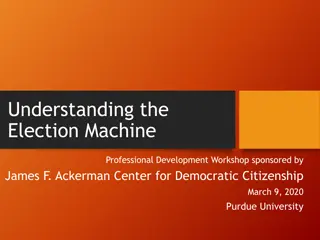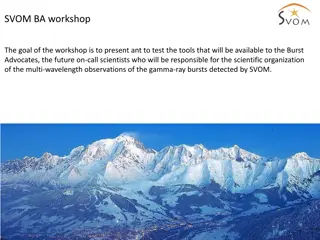
Advanced Techniques in Fault Detection and Machine Learning for Particle Accelerators
Explore cutting-edge methodologies in fault detection and machine learning applied to particle accelerators, emphasizing data-driven approaches and the quest for maximum availability and operational efficiency. Learn about the complexities of fault diagnosis, model-based solutions, and challenges in handling diverse data types and failure scenarios. Stay informed about the latest advancements in accelerator technology and maintenance strategies for improved performance.
Download Presentation

Please find below an Image/Link to download the presentation.
The content on the website is provided AS IS for your information and personal use only. It may not be sold, licensed, or shared on other websites without obtaining consent from the author. If you encounter any issues during the download, it is possible that the publisher has removed the file from their server.
You are allowed to download the files provided on this website for personal or commercial use, subject to the condition that they are used lawfully. All files are the property of their respective owners.
The content on the website is provided AS IS for your information and personal use only. It may not be sold, licensed, or shared on other websites without obtaining consent from the author.
E N D
Presentation Transcript
Inverse Problems: THz- and phase space tomography and machine learning Andrea Santamaria Garcia, Erik Br ndermann, Stefan Funkner, 22 Nov 2021, 13:30-17:35 Mathematik in der Teilchen- und Astroteilchenphysik: Diskussion zuk nftiger Zusammenarbeit und Identifikation gemeinsamer Projekte www.kit.edu KIT The Research University in the Helmholtz Association
Particle accelerators one of the most complex machines in the world! A feat of enginering Magnet systems Radiofrequency cavities Diagnostics Vacuum Cryogenics Detectors for applied research (and industry, medicine) R&D Users (experiments) currently more than 30,000 accelerators in operation around the world 22. Nov 2021 Erik Br ndermann, Stefan Funkner, Andrea Santamaria Garcia Institute for Beam Physics and Technology (IBPT) 2
Particle accelerators one of the most complex machines in the world! Goal for any accelerator: maximum availability = useful beamtime Minimum mean time between failures Prevention / early detection / fast interventions Minimum time to set-up & optimize operation modes 22. Nov 2021 Erik Br ndermann, Stefan Funkner, Andrea Santamaria Garcia Institute for Beam Physics and Technology (IBPT) 3
Fault detection to increase availability The fault detection problem Alarm Isolation Estimation Labeling an event as faulty or normal (binary classification) What type of fault has happened (explainability) What is the magnitude of the failure (non-functional or functional in a degraded state?) - Model-based fault diagnosis: residual signal = Model Observed signal discrete Kalman filter eq. used to identify faults The majority of the time we don t have a model Models are always approximations 22. Nov 2021 Erik Br ndermann, Stefan Funkner, Andrea Santamaria Garcia Institute for Beam Physics and Technology (IBPT) 4
Data-driven methods for fault detection Challenges Data asymmetry Heterogeneity of the failure types Data sampling rate Autoencoder neural network Latent space Sparse representation focusing on key properties Date Description 12.04.2021 22.10.2020 16.10.2019 06.09.2019 04.09.2019 28.10.2016 BPM restart loop Sudden variation of BPM charge button Sudden variation of BPM charge button Faulty fan in BPM cooling system BPM RAM usage warning No data readout Output Input data Normal operation data (no failures) Loss threshold Anomaly would be above threshold BPM = Beam Position Monitor 22. Nov 2021 Erik Br ndermann, Stefan Funkner, Andrea Santamaria Garcia Institute for Beam Physics and Technology (IBPT) 5
Data-driven methods for fault detection Feature selection & crafting Autoencoder neural network Which accelerator signals are correlated and are relevant to the device failure? Latent space Sparse representation focusing on key properties Data cleaning Based on domain knowledge Time series analysis Which time interval is representative? How to normalize different signals? Autocorrelation, seasonality, stationarity Segmentation, smoothing, signal estimation Output Input data Normal operation data (no failures) Loss threshold Anomaly would be above threshold 22. Nov 2021 Erik Br ndermann, Stefan Funkner, Andrea Santamaria Garcia Institute for Beam Physics and Technology (IBPT) 6
Data-driven methods for fault detection Feature selection & crafting Which accelerator signals are correlated and are relevant to the device failure? Data cleaning Based on domain knowledge Important for any machine learning method Time series analysis Which time interval is representative? How to normalize different signals? Autocorrelation, seasonality, stationarity Segmentation, smoothing, signal estimation 22. Nov 2021 Erik Br ndermann, Stefan Funkner, Andrea Santamaria Garcia Institute for Beam Physics and Technology (IBPT) 7
The final challenge The curse of dimensionality or Hughes phenomenon Clustering becomes impossible because the distance of observations appears equal ML method Classifier Regressor Fixed number of data samples Sparse data Number of features Predictive power Accelerators have hundreds of thousands of not-so-statistically-significant signals Feature selection / dimensionality reduction is key 22. Nov 2021 Erik Br ndermann, Stefan Funkner, Andrea Santamaria Garcia Institute for Beam Physics and Technology (IBPT) 8






















